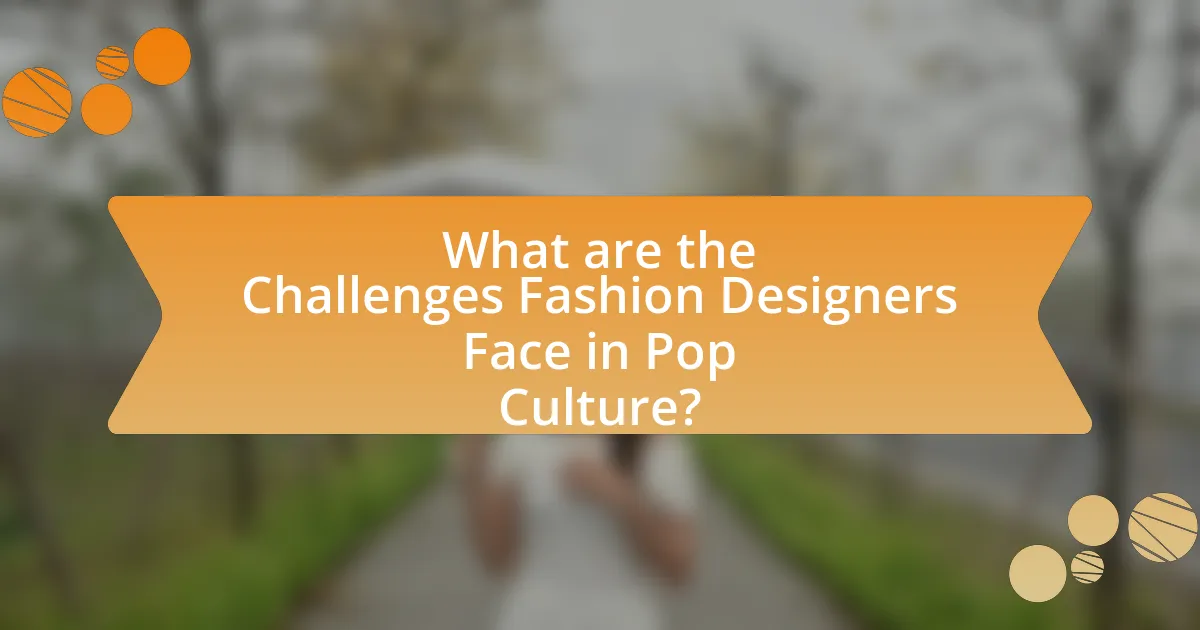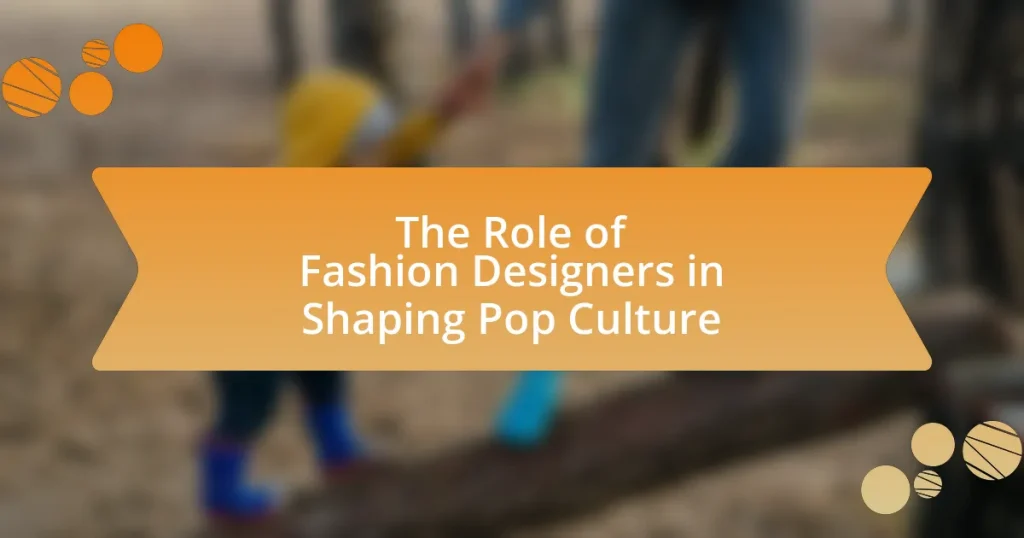Fashion designers play a pivotal role in shaping pop culture by influencing trends, aesthetics, and societal norms through their creative expressions. They create iconic styles that reflect and challenge cultural values, as demonstrated by designers like Coco Chanel and Alexander McQueen. The article explores how fashion designers impact societal trends, engage with cultural movements, and collaborate with other industries, particularly in entertainment and music. It also addresses the challenges they face, such as sustainability concerns and the pressures of fast fashion, while highlighting best practices for aspiring designers to enhance their influence in the fashion landscape.

What is the Role of Fashion Designers in Shaping Pop Culture?
Fashion designers play a crucial role in shaping pop culture by influencing trends, aesthetics, and social norms through their creative expressions. They create iconic styles that often reflect and challenge societal values, as seen in the works of designers like Coco Chanel, who popularized the modern woman’s silhouette, or Alexander McQueen, who used fashion to comment on issues like identity and culture. Their designs frequently appear in media, including films and music videos, further embedding these styles into the cultural zeitgeist. For instance, the impact of streetwear, popularized by designers like Virgil Abloh, has transformed fashion into a significant aspect of youth culture, merging art, music, and social commentary. Thus, fashion designers not only create clothing but also serve as cultural commentators, shaping and reflecting the zeitgeist of their times.
How do fashion designers influence societal trends?
Fashion designers influence societal trends by creating styles that reflect and shape cultural values and social norms. Their collections often introduce new aesthetics and ideas that resonate with the public, leading to widespread adoption of these trends. For instance, the rise of sustainable fashion, championed by designers like Stella McCartney, has prompted a societal shift towards environmental consciousness in consumer behavior. Additionally, fashion designers often collaborate with celebrities and influencers, amplifying their reach and impact on societal perceptions of beauty and identity. This interplay between design and culture is evident in how trends such as athleisure have transformed everyday wear, merging comfort with style and reflecting a more casual societal attitude.
What are the key elements of fashion that resonate with pop culture?
The key elements of fashion that resonate with pop culture include trends, celebrity influence, social media, and cultural movements. Trends reflect the current societal interests and are often driven by fashion designers who interpret and innovate styles that capture public attention. Celebrity influence plays a significant role, as public figures often set fashion standards that fans emulate, creating a direct link between celebrity culture and fashion choices. Social media platforms amplify these connections, allowing for rapid dissemination of fashion trends and enabling users to engage with and promote styles in real-time. Cultural movements, such as feminism or environmentalism, also shape fashion, as designers incorporate these themes into their collections, reflecting broader societal values and concerns. For instance, the rise of sustainable fashion aligns with increasing awareness of environmental issues, demonstrating how fashion can serve as a vehicle for cultural expression and change.
How do fashion designers reflect cultural movements through their work?
Fashion designers reflect cultural movements through their work by incorporating societal themes, values, and aesthetics into their collections. For instance, during the 1960s, designers like André Courrèges and Pierre Cardin embraced the youth counterculture and space age, creating bold, geometric designs that mirrored the era’s revolutionary spirit and technological optimism. This alignment with cultural shifts is evident in the adoption of materials and styles that resonate with contemporary social issues, such as sustainability and inclusivity, seen in brands like Stella McCartney and Savage X Fenty. By responding to and interpreting the zeitgeist, fashion designers not only influence trends but also serve as a mirror to the evolving cultural landscape.
Why is the relationship between fashion and pop culture significant?
The relationship between fashion and pop culture is significant because it reflects societal values, trends, and identities. Fashion serves as a visual language that communicates cultural shifts and influences public perception. For instance, the rise of streetwear in the 1990s, popularized by figures like Kanye West and brands like Supreme, illustrates how fashion can embody youth culture and social movements. This interplay shapes consumer behavior and drives the fashion industry, as seen in the increasing demand for sustainable fashion in response to environmental concerns. Thus, the connection between fashion and pop culture is a dynamic force that shapes and is shaped by contemporary society.
What historical examples illustrate this relationship?
Fashion designers have significantly influenced pop culture, with notable historical examples including Coco Chanel’s introduction of the modern women’s suit in the 1920s, which challenged traditional gender norms and promoted women’s liberation. Another example is the impact of Yves Saint Laurent’s “Le Smoking” tuxedo for women in the 1960s, which further blurred gender lines and became a symbol of feminist empowerment. Additionally, the collaboration between designer Gianni Versace and pop icons like Madonna in the 1990s showcased how fashion can intersect with music and celebrity culture, reinforcing the designer’s role in shaping public perception and trends. These instances illustrate the profound relationship between fashion design and the evolution of cultural identity and social movements.
How do fashion designers contribute to the evolution of cultural identity?
Fashion designers contribute to the evolution of cultural identity by creating garments that reflect and challenge societal norms, values, and traditions. Through their work, designers often draw inspiration from diverse cultural backgrounds, which helps to promote cultural exchange and awareness. For example, designers like Vivienne Westwood have incorporated punk aesthetics that challenge mainstream culture, while others, such as Issey Miyake, have blended traditional Japanese techniques with modern design, showcasing the fusion of cultures. This interplay not only influences fashion trends but also shapes public perceptions of cultural identity, as seen in the global popularity of streetwear that often incorporates elements from various cultural movements.

How do Fashion Designers Collaborate with Other Industries?
Fashion designers collaborate with other industries through partnerships that enhance brand visibility and creativity. For instance, collaborations with the technology sector have led to innovative wearable tech, such as smartwatches integrated with fashion aesthetics, exemplified by the partnership between Apple and Hermès. Additionally, fashion designers often work with the film industry to create costumes that define characters and influence trends, as seen in the collaboration between costume designer Edith Head and various Hollywood productions. These cross-industry collaborations not only expand the reach of fashion but also contribute to the evolution of cultural narratives, demonstrating the significant impact fashion designers have on shaping pop culture.
What roles do fashion designers play in the entertainment industry?
Fashion designers play a crucial role in the entertainment industry by creating costumes and wardrobe pieces that define characters and enhance storytelling. Their designs contribute to the visual identity of films, television shows, and music performances, influencing audience perception and engagement. For instance, iconic costumes from films like “Star Wars” and “The Great Gatsby” have become cultural symbols, showcasing how fashion can elevate a narrative. Additionally, fashion designers often collaborate with celebrities for red carpet events, shaping trends and public image, as seen with designers like Versace and Gucci dressing high-profile stars. This interplay between fashion and entertainment not only drives consumer interest but also reflects and shapes societal trends, underscoring the significant impact of fashion designers in the entertainment landscape.
How do fashion choices in film and television impact public perception?
Fashion choices in film and television significantly shape public perception by influencing trends, social norms, and individual identity. For instance, iconic costumes from films and series often lead to increased consumer interest in similar styles, as seen with the popularity of the “Friends” TV show, where characters’ outfits sparked a resurgence in 1990s fashion. Research indicates that viewers often emulate the styles of their favorite characters, which can lead to shifts in mainstream fashion trends. A study published in the Journal of Fashion Marketing and Management found that characters’ clothing choices can affect viewers’ attitudes and behaviors, reinforcing the idea that fashion in media plays a crucial role in shaping societal perceptions and personal self-image.
What collaborations between fashion designers and musicians have shaped trends?
Collaborations between fashion designers and musicians that have shaped trends include the partnership between Karl Lagerfeld and Rihanna, which resulted in the iconic 2014 Met Gala look that blended high fashion with street style. Another significant collaboration is the collaboration between Beyoncé and Balmain, which showcased bold, vibrant designs that influenced contemporary women’s fashion. Additionally, the collaboration between Pharrell Williams and Adidas led to the popularization of the Hu NMD sneaker line, merging music culture with athletic wear. These partnerships have not only created memorable fashion moments but have also driven trends in both industries, demonstrating the powerful intersection of music and fashion.
How do fashion designers engage with social movements?
Fashion designers engage with social movements by using their platforms to raise awareness and promote causes through their collections and public statements. For instance, designers like Stella McCartney advocate for sustainable fashion and animal rights, integrating these themes into their designs and marketing campaigns. Additionally, during events like Fashion Weeks, designers often showcase collections that reflect social issues, such as racial equality or gender rights, thereby influencing public discourse. The 2018 Met Gala, themed “Heavenly Bodies: Fashion and the Catholic Imagination,” saw designers like Alessandro Michele use religious symbolism to comment on contemporary social issues, illustrating how fashion can intersect with cultural conversations.
What are some examples of fashion campaigns that support social causes?
Some examples of fashion campaigns that support social causes include the “Fashion for Relief” initiative founded by Naomi Campbell, which raises funds for disaster relief efforts, and the “I Am an Immigrant” campaign by the fashion brand “The Real Real,” which promotes awareness and support for immigrant rights. Additionally, the “Pride Collection” by various brands, including Nike and Adidas, celebrates LGBTQ+ rights and donates a portion of sales to related charities. These campaigns demonstrate how fashion can be leveraged to address social issues and mobilize support for various causes.
How do designers use their platforms to advocate for change?
Designers use their platforms to advocate for change by leveraging their visibility and influence to promote social, environmental, and political issues. For instance, many designers create collections that raise awareness about climate change, such as Stella McCartney, who emphasizes sustainable fashion practices. Additionally, designers often collaborate with non-profit organizations to support causes like racial equality and gender rights, exemplified by brands like Balenciaga, which has engaged in campaigns addressing social justice. These actions not only reflect the designers’ values but also inspire their audiences to engage with these critical issues, demonstrating the significant impact of fashion on societal change.

What are the Challenges Fashion Designers Face in Pop Culture?
Fashion designers face several challenges in pop culture, including rapidly changing trends, sustainability concerns, and the impact of social media. Rapidly changing trends require designers to constantly innovate and adapt, often leading to increased pressure and burnout. Sustainability concerns arise as consumers demand eco-friendly practices, pushing designers to find sustainable materials and production methods. Additionally, social media influences public perception and can lead to instant feedback, which may not always be favorable, complicating the designer’s creative process. These challenges highlight the complex environment in which fashion designers operate, necessitating a balance between creativity, consumer expectations, and ethical considerations.
How do market demands affect a designer’s creative process?
Market demands significantly influence a designer’s creative process by dictating the trends, styles, and functionalities that resonate with consumers. Designers must analyze consumer preferences, sales data, and market trends to create products that align with current demands, ensuring their work is commercially viable. For instance, a report by McKinsey & Company highlights that 66% of fashion executives believe that understanding consumer behavior is crucial for successful design. This data underscores the necessity for designers to adapt their creative visions to meet market expectations while maintaining their unique artistic identity.
What pressures do designers face from fast fashion trends?
Designers face significant pressures from fast fashion trends, primarily due to the demand for rapid production cycles and constant innovation. Fast fashion brands prioritize speed and affordability, compelling designers to create collections quickly, often sacrificing quality and sustainability. This pressure is evident in the industry’s shift towards “see now, buy now” models, which require designers to produce garments in a matter of weeks rather than months. Additionally, the prevalence of trend replication by fast fashion retailers undermines designers’ original concepts, leading to a lack of creative ownership and financial viability. According to a 2021 report by the Ellen MacArthur Foundation, the fast fashion industry contributes to 92 million tons of waste annually, highlighting the environmental impact of these pressures on designers and the broader fashion ecosystem.
How do cultural appropriation issues impact fashion design?
Cultural appropriation issues significantly impact fashion design by influencing the ethical considerations and creative choices of designers. Designers face scrutiny when they incorporate elements from cultures that are not their own, leading to potential backlash from communities who feel their cultural symbols are being misused or commodified. For instance, the controversy surrounding the use of Native American headdresses in fashion shows highlights how cultural appropriation can result in public outcry and calls for accountability. This scrutiny can lead designers to adopt more respectful practices, such as collaborating with cultural representatives or ensuring that their designs honor the original context, thereby fostering a more inclusive approach to fashion.
What strategies can fashion designers use to remain relevant?
Fashion designers can remain relevant by embracing sustainability, leveraging technology, and engaging with diverse audiences. Sustainability has become a critical focus in the fashion industry, with consumers increasingly favoring brands that prioritize eco-friendly practices; for instance, a 2021 McKinsey report highlighted that 67% of consumers consider sustainability when making a purchase. Leveraging technology, such as virtual reality and augmented reality, allows designers to create immersive experiences that attract tech-savvy consumers; brands like Balenciaga have successfully utilized these technologies in their marketing strategies. Additionally, engaging with diverse audiences through inclusive sizing and culturally relevant designs helps designers connect with a broader customer base, as evidenced by the rise of brands like Savage X Fenty, which has gained significant popularity for its inclusivity.
How can designers balance innovation with consumer expectations?
Designers can balance innovation with consumer expectations by conducting thorough market research to understand consumer preferences while integrating cutting-edge design elements. This approach allows designers to create products that resonate with consumers’ desires for novelty and familiarity. For instance, a study by McKinsey & Company highlights that 66% of consumers are willing to pay more for sustainable fashion, indicating a growing expectation for innovation in sustainability alongside traditional design values. By aligning innovative practices with consumer insights, designers can effectively meet market demands while pushing creative boundaries.
What role does sustainability play in modern fashion design?
Sustainability plays a crucial role in modern fashion design by driving the industry towards environmentally responsible practices. Designers increasingly prioritize sustainable materials, such as organic cotton and recycled fabrics, to reduce environmental impact. According to a 2021 McKinsey report, 67% of consumers consider sustainability when making fashion purchases, indicating a significant market demand for eco-friendly options. This shift not only influences design choices but also encourages brands to adopt circular economy principles, minimizing waste through recycling and upcycling initiatives.
What are the best practices for aspiring fashion designers in pop culture?
Aspiring fashion designers in pop culture should focus on building a strong personal brand and networking effectively within the industry. Establishing a unique aesthetic and voice helps designers stand out in a competitive market, as evidenced by successful designers like Alexander Wang and Marc Jacobs, who have cultivated distinct identities that resonate with their audiences. Additionally, engaging with social media platforms allows designers to showcase their work, connect with influencers, and gain visibility, which is crucial in today’s digital landscape. According to a 2021 study by the Fashion Institute of Technology, 70% of fashion professionals believe that social media presence significantly impacts a designer’s success. Lastly, continuous learning through workshops, internships, and collaborations with established designers enhances skills and industry knowledge, further solidifying a designer’s place in pop culture.
How can networking enhance a designer’s influence in pop culture?
Networking enhances a designer’s influence in pop culture by facilitating connections with key industry figures, media, and influencers. These relationships enable designers to showcase their work to a broader audience, gain access to collaborative opportunities, and receive endorsements that amplify their visibility. For instance, designers who network effectively can participate in high-profile events like Fashion Week, where they can present their collections to influential celebrities and fashion editors, thereby increasing their cultural relevance. Additionally, studies show that 85% of job positions are filled through networking, highlighting its critical role in career advancement and influence within the fashion industry.
What skills are essential for success in the fashion industry?
Essential skills for success in the fashion industry include creativity, technical design proficiency, strong communication abilities, and an understanding of market trends. Creativity allows designers to innovate and develop unique concepts that resonate with consumers. Technical design proficiency ensures that designers can translate their ideas into wearable garments, utilizing tools like CAD software. Strong communication abilities are crucial for collaborating with teams and presenting ideas effectively to stakeholders. Understanding market trends enables designers to anticipate consumer preferences and adapt their collections accordingly, which is supported by industry reports indicating that trend-aware brands outperform their competitors.



